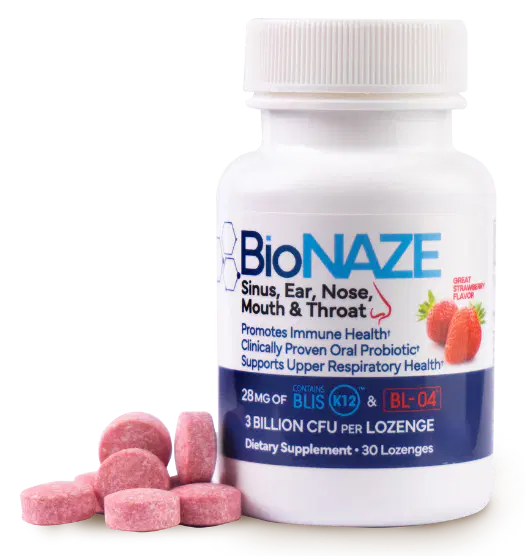Here’s How To Actually Stop Sinus Drainage

Published January 28, 2021
It’s funny how we take clear sinuses for granted until we experience the bothersome discomfort of sinus infections. The linings of our sinuses and noses produce mucus that traps particles, preventing infection from happening. Additionally, our sinuses play a crucial role in draining that mucus into our stomach to dispose of it. On most days, we don’t even notice this going on behind the scenes because our sinuses are healthy. However, when sinus conditions arise, you will immediately feel it. With that, we’re here today to talk about sinus drainage – what it is and how to stop it.

What is sinus drainage?
Sinus drainage, or postnasal drip, happens when excess mucus from a runny nose drains down the back of your throat. Under normal circumstances, having a layer of mucus in the back of your throat is healthy; this layer protects against illness and provides lubrication. When infection occurs, this can trigger the overproduction of mucus, which in turn may lead to sinus drainage.
Another well-known term for sinus drainage or postnasal drip is upper airway cough syndrome, as this condition typically leads to itchy and persistent coughing. Additionally, mucus may be much thicker or thinner than normal, making drainage that much more apparent.
Causes
Here are some of the common causes of postnasal drip:
- Allergies
- Viral infections (like the common cold)
- Sinus infections or sinusitis (the inflammation of the sinuses)
- Deviated septum (when the bony cartilage separating the nostrils is obstructed)
- Dry air
- Dehydration
- Sudden changes in weather
- Acid reflux (GERD)
Symptoms
Sinus drainage typically lasts for a few days to a few weeks. However, it can be chronic in some cases. You have a higher risk of having chronic sinus drainage if you also have chronic sinusitis. Here are the symptoms that commonly come with sinus drainage:
- Persistent itching in the back of your throat
- Persistent cough
- Hoarse voice
- Sore throat
- Feeling a constant need to clear your throat
- Feeling a lump or mass in the back of your throat
Treatment
As with most conditions, you’ll want to treat the underlying cause to relieve yourself of it effectively. We’ve listed the different treatment options, including home remedies, that you might want to try.
Drink your water
Sinus drainage is often caused by dehydration. If our bodies do not have enough water to keep the sinus linings moist, the mucus that’s produced can become thick. Drinking a healthy amount of water in a day is crucial to thinning your mucus and draining your sinuses.
Antibiotics
Antibiotics capably treat bacterial infections if that’s what’s causing your sinus drainage.
Antihistamines
One of the most common causes of postnasal drip and sinus drainage is allergies. Depending on what exactly it is you’re allergic to, antihistamines can be effective in helping your immune system manage the allergy.
Chicken soup
Ah yes, the age-old remedy for colds and the sniffles – chicken soup. A study conducted back in 2000 showed that chicken soup interestingly has healing properties in reducing inflammation caused by infection. Scientists attribute this to the antioxidant and anti-inflammatory effects that some of the ingredients have.
Decongestants
Decongestants and oral steroids help by reducing the inflammation in your sinus lining. The less inflamed your sinus lining is, the less blockage you will experience.
Nasal irrigation
Nasal irrigation is an effective method of relieving nasal congestion and irritation. This treatment option requires you to flush out your nasal passages with a saline solution. There is special equipment like squeeze bottles and neti pots that are specifically designed for this job.
Steam Inhalation
Steam serves two purposes: humidifying your sinuses and loosening mucus. Both of these effects will likely lead to relief from sinus congestion symptoms. The way you do this is by grabbing a bowl of hot water and a towel. You may also enhance this experience by adding a few drops of menthol, eucalyptus, or camphor oil to the water. Place the bowl on a table and bend over so that your face is directly above it. You’ll then want to drape your towel over the sides of your head, trapping the steam. You may also take hot showers, but the effects aren’t as pronounced as they are with this method.
Alternating warm and cold compresses
Sinus pain is one of the primary symptoms that accompany sinus drainage. If you find it unbearable, resulting in an extremely heavy head, this method has proven effective. It involves alternately placing warm and cold compresses on your cheeks, under your eyes.
Surgery
If sinus drainage is brought about by a sinus infection resulting from a severely deviated septum, you may need surgery to correct it. An ENT doctor will assess first your sinus drainage before suggesting corrective surgery to solve your problem.
Benefit From The Latest Advancements In Probiotic Science With Bionaze
Bionaze is a proprietary blend of probiotics proven to promote ear, nose, and throat health, improve digestion, and support your immune system. The active ingredients BLIS K12, and BL-04 are considered among the best probiotics according to science.
Get 25% Off Your First Order when you use BIO25 at checkout!

This Content Has Been Reviewed For Factual Accuracy
This content has undergone thorough fact-checking by our team of internal experts. Learn more about the meticulous editorial standard for our website here.
ADVERTISEMENT

About The Author
Judy Ponio is a professional writer based in the Philippines. Her commitment to communicating factual content in when writing is unmatched. She works hard to cross check reputable sources to ensure her work uses accurate facts.




